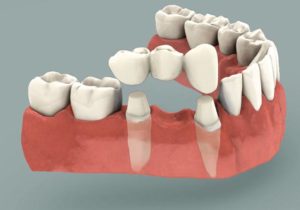
DR. YOGITA PATIL
M.D.S. /Prosthodontist
Profile
| ✓ She has completed her graduation and post-graduation(Prosthodontics &Crown &Bridge) from Tatyasaheb Kore Dental College &Research Centre, Warnanagar | ✓ She had done a paper presentation on management of compromised edentulous ridges. |
| ✓ Attended CDE programs on full mouth rehabilitation. | ✓ She had done a table clinic on implant provisional restoration. |
| ✓ He was awarded for the best scientific paper presentation at IES-FODI conference,Kochi-2010 |
BRIDGES
Dental bridges literally bridge the gap created by one or more missing teeth.
A bridge is made up of two or more crowns for the teeth on either side of the gap — these two or more anchoring teeth are called abutment teeth and a false tooth/teeth in between.
These false teeth are called pontics and can be made from alloys, porcelain, or a combination of these materials. Dental bridges are supported by natural teeth or implants.

FAQ
What Is a Bridge?
Bridges are ideal for people who don’t like dentures and only have one or two teeth missing. Bridges are usually made by crowning the teeth on either side of the gap and attaching a false tooth in the middle. They are fixed in the same way as crowns. These bridges are usually made of precious metal bonded to porcelain.
What Are The Benefits Of Dental Bridges?
Bridges can:
- Restore your smile
- Restore the ability to properly chew and speak
- Maintain the shape of your face
- Distribute the forces in your bite properly by replacing missing teeth
- Prevent remaining teeth from drifting out of position
What Is The Process for Getting a Dental Bridge?
During the first visit for getting a dental bridge, the abutment teeth are prepared. Preparation involves recontouring these teeth by removing a portion of enamel to allow room for a crown to be placed over them. Next, impressions of the teeth are made, which serve as a model from which the bridge, pontic, and crowns will be made by a dental lab. Your dentist will make a temporary bridge to wear to protect the exposed teeth and gums while the bridge is being made.
During the second visit, your temporary bridge will be removed and the new porcelain or metal bridge will be checked and adjusted, as necessary, to achieve a proper fit. Multiple visits may be required to check the fit of the metal framework and bite. This is dependent on each individual’s case. If the dental bridge is a fixed bridge, your dentist may temporarily cement it in place for a couple of weeks to make sure it is fitting properly. After a couple of weeks, the bridge is cemented into place.
How Long Do Dental Bridges Last?
Dental bridges can last five to 15 years and even longer. With good oral hygiene and regular checkups, it is not unusual for the life span of a fixed bridge to be over 10 years.
Will It be Difficult To Eat With a Dental Bridge?
Replacing missing teeth with a dental bridge should actually make eating easier. Until you become accustomed to the bridge, eat soft foods that have been cut into small pieces.
Will The Dental Bridge Change How I Speak?
It can be difficult to speak clearly when teeth are missing. Wearing a dental bridge with the anterior teeth in their proper relationship will help you speak properly.
How Do I Care for a Bridge?
It is important to keep remaining teeth healthy and strong as the success of the bridge (depending on the type selected) depends on the solid foundation offered by the surrounding teeth. Brushing twice a day and flossing daily helps prevent tooth decay and gum disease that can lead to tooth loss. Your dentist or dental hygienist can demonstrate how to properly brush and floss teeth. Keeping a regular cleaning schedule will help diagnose problems at an early stage when treatment has a better prognosis. Selecting a balanced diet for proper nutrition is also important.
